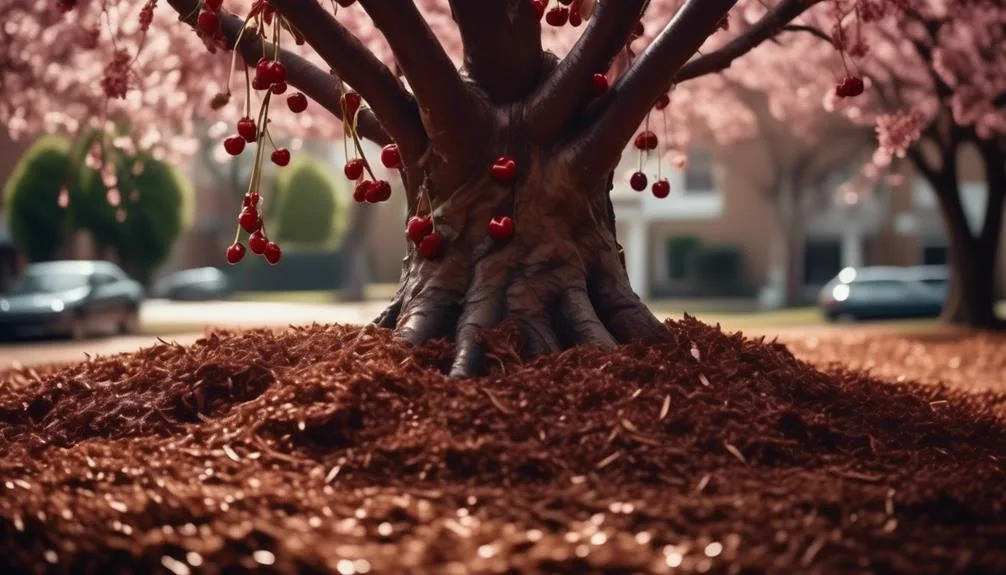Caring for your cherry tree is essential for its health and fruit production. Mulching plays a vital role in this. From choosing the right mulch to avoiding common mistakes, there are key techniques to help your cherry tree thrive.
Understanding the best mulching practices can create an ideal environment for growth and productivity.
Choosing the Right Mulch Material
When choosing the right mulch material for your cherry trees, consider the specific needs of your trees and the local climate. There are various mulch types to choose from, each with its own pros and cons.
Organic mulches like wood chips and bark nuggets decompose over time, enriching the soil, but may attract pests. Inorganic mulches such as stones or landscape fabric offer long-lasting weed control but don't improve soil quality.
In terms of mulching frequency, it's best to apply a 2- to 4-inch layer of mulch once a year, preferably in spring or early summer. This helps retain soil moisture, regulate soil temperature, and suppress weed growth. Remember to keep the mulch a few inches away from the tree trunk to prevent rot.
Applying Mulch at the Proper Depth
For proper mulching depth, ensure that the mulch layer is consistently 2 to 4 inches thick around the base of your cherry trees, maintaining a few inches of space from the trunk to prevent potential rot. The proper mulching depth is crucial to maximize mulch benefits, such as moisture retention, weed suppression, and soil insulation. Here's a simple guide to help you achieve the ideal mulch thickness:
| Mulch Type | Ideal Thickness | Benefits |
|---|---|---|
| Wood Chips | 3 inches | Improves soil structure and moisture retention |
| Compost | 2 inches | Adds nutrients and enhances soil fertility |
| Pine Straw | 4 inches | Provides excellent insulation and weed control |
| Shredded Leaves | 2.5 inches | Enriches soil as it decomposes and suppresses weeds |
| Cocoa Hulls | 3.5 inches | Adds a pleasing fragrance and retains moisture |
Maintaining the recommended mulch thickness will help ensure your cherry trees thrive.
Creating a Mulch Ring Around the Tree
Consider encircling the base of your cherry tree with a ring of mulch to promote moisture retention and suppress weed growth. This method helps create an ideal environment for your tree to thrive.
When applying the mulch ring, ensure that it's 2-4 inches deep and extends 2-3 feet from the trunk. This will help retain moisture, allowing the soil to stay consistently damp, which is crucial for the healthy growth of cherry trees.
Additionally, the mulch acts as a barrier, preventing weed growth around the tree. By creating a weed-free zone, your cherry tree can receive the nutrients and water it needs without competition.
This technique not only benefits the tree but also makes maintenance easier for you.
Maintaining Mulch Throughout the Year
To maintain the mulch around your cherry tree throughout the year, regularly check for any signs of compaction and refresh it as needed to ensure optimal moisture retention and weed suppression. Mulch decomposition is a natural process, so it is important to monitor the mulch layer and replenish it when it breaks down. Additionally, proper mulch watering is crucial for its effectiveness. Here's a simple guide to maintain the mulch around your cherry tree:
| Mulch Maintenance Tips | Description |
|---|---|
| Check for Compaction | Gently break up any compacted areas to allow for better air and water penetration. |
| Refresh Mulch | Add a 2-3 inch layer of fresh mulch to compensate for decomposition and maintain weed control. |
| Water Mulch | Ensure the mulch stays moist by watering it along with the tree, especially during dry periods. |
| Monitor Decomposition | Keep an eye on the mulch layer and replenish it as it decomposes to maintain its effectiveness. |
Regularly tending to the mulch around your cherry tree will help promote its health and growth.
Avoiding Common Mulching Mistakes
To ensure proper mulching for your cherry tree, it's important to be aware of common mistakes that can affect the tree's health and growth.
One of the common mulching misconceptions is piling up mulch against the tree trunk. This can lead to excess moisture retention, encouraging rot and disease.
Another mistake is using mulch that hasn't been properly aged or composted, which can deplete the soil of nitrogen as it breaks down.
Additionally, avoid creating a mulch volcano around the base of the tree, as it can suffocate the roots and lead to poor growth.
Remember, proper mulching offers numerous benefits such as moisture retention, weed suppression, and insulation for the roots.
Conclusion
Mastering the best mulching techniques for cherry trees is the key to ensuring their long-term health and productivity. By choosing the right material, applying it correctly, and maintaining it diligently, you can create optimal growing conditions for your trees.
With these practices in place, you can look forward to abundant harvests and thriving cherry trees in the years ahead. Happy mulching!
Mark Hoffman is a dedicated arborist and tree care specialist with over a decade of experience. His love for trees began when he visited Yosemite National Park as a teenager and was awestruck by the giant sequoias. Mark pursued his passion by studying forestry at Michigan Technological University, where he earned a Bachelor of Science degree.
Since then, he has worked tirelessly in the field of arboriculture, helping to preserve and protect trees in his community. His expertise and dedication have made him a respected leader in the industry and a valuable resource for anyone seeking advice on tree care.
